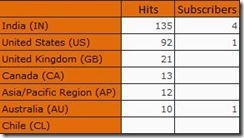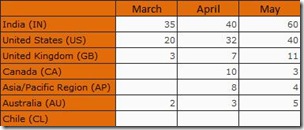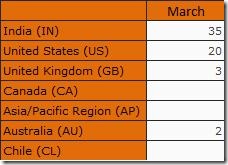【转载】NonEmpty和Non Empty的区别
转载来源:http://www.ssas-info.com/analysis-services-articles/50-mdx/2196-mdx-non-empty-vs-nonempty
One of my favourite questions in MDX is the difference between Non Empty and NonEmpty because even though many people use them daily to remove NULLS from their queries, very few understand the working behind it. Many times, I have even got answers like “there is a space between Non and Empty, that is the difference”. The objective of this post is to clearly differentiate between the two.
Let us say my initial query is
SELECT
{
[Measures].[Hits]
,[Measures].[Subscribers]
,[Measures].[Spam]
} ON COLUMNS
,{
[Geography].[Country].Children
} ON ROWS
FROM [Blog Statistics];
This will give the following output

NON EMPTY
Non Empty is prefixed before the sets defining the axes and is used for removing NULLs. Let us see what happens when we add Non Empty on the Rows axis.
SELECT
{
[Measures].[Hits]
,[Measures].[Subscribers]
,[Measures].[Spam]
} ON COLUMNS
,NON EMPTY
{
[Geography].[Country].Children
} ON ROWS
FROM [Blog Statistics];
The output is shown below

You will notice that Chile (CL) has been filtered out while rows like UK, Canada, etc are still there even if they have NULLs for some of the measures. In short, only the rows having NULL for all the members of the set defined in the column axis is filtered out. This is because the Non Empty operator works on the top level of the query. Internally, the sets defined for the axes are generated first and then the tuples having NULL values are removed. Now that we know how NON EMPTY works, it shouldn’t be hard for us to tell the output of the below query
SELECT
NON EMPTY
{
[Measures].[Hits]
,[Measures].[Subscribers]
,[Measures].[Spam]
} ON COLUMNS
,{
[Geography].[Country].Children
} ON ROWS
FROM [Blog Statistics];
The output is shown below

NONEMPTY()
The NonEmpty() returns the set of tuples that are not empty from a specified set, based on the cross product of the specified set with a second set. Suppose we want to see all the measures related to countries which have a non-null value for Subscribers
SELECT
{
[Measures].[Hits]
,[Measures].[Subscribers]
,[Measures].[Spam]
} ON COLUMNS
,{
NonEmpty
(
[Geography].[Country].Children
,[Measures].[Subscribers]
)
} ON ROWS
FROM [Blog Statistics];
This will give the following output

As you can see, the NonEmpty operator takes all the rows having a not NULL value for Subscribers in the rows and then displays all the measures defined in the column axis. Basically what happens internally is that NonEmpty is evaluated when the sets defining the axis are evaluated. So at this point of time, there is no context of the other axes. What I said now can be better understood from the following example

Now, we write the below query
SELECT
{[Date].[Month].[March]} ON COLUMNS
,{
[Geography].[Country].Children
} ON ROWS
FROM [Blog Statistics]
WHERE
[Measures].[Hits];
Output is given below

Think for a while and predict which all rows would be returned when the NonEmpty operator is applied on the rows
SELECT
{[Date].[Month].[March]} ON COLUMNS
,{
NonEmpty([Geography].[Country].Children)
} ON ROWS
FROM [Blog Statistics]
WHERE
[Measures].[Hits];
If you guessed just IN, US, GB and AU, please go back and read once again. If you replied All rows except Chile, full marks to you, you have been an attentive reader. The reason is because NonEmpty is evaluated when the set defining the axis is evaluated (here, Country) and at that point of time, NonEmpty is evaluated for each member of the country against the default member of the Date dimension (which would be ALL generally). As you can see, we already have values for CA and AP for other months and hence they will not be filtered out.
Optimizing Non Empty by using NonEmpty
Ok, now you know how Non Empty and NonEmpty works internally and we can apply this knowledge to optimize our queries. Suppose there is a complex logic in our axes like finding all the countries that have 30 or more hits in any month. The query is given below
SELECT
{[Measures].[Hits]} ON COLUMNS
,{
Filter
(
[Geography].[Country].Children
*
[Date].[Month].Children
,
[Measures].[Hits] > 30
)
} ON ROWS
FROM [Blog Statistics];
Now my time dimension will have 10 years of data, which means around 120 (10*12) members for the month attribute and my country attribute may have let’s say, 100 members. Now even though I just have 3 months of data for 10 countries for hits, the filter function will need to go through all the combinations of country and month (120*100 combinations). Instead of that, we can just use the NonEmpty operator and bring down the combinations to less than 30 (3 months*10 countries) by using the below query
SELECT
{[Measures].[Hits]} ON COLUMNS
,{
Filter
(
NonEmpty
(
[Geography].[Country].Children
*
[Date].[Month].Children
,[Measures].[Hits]
)
,
[Measures].[Hits] > 30
)
} ON ROWS
FROM [Blog Statistics];
【转载】NonEmpty和Non Empty的区别的更多相关文章
- NonEmpty和Non Empty的区别[转]
One of my favourite questions in MDX is the difference between Non Empty and NonEmpty because even t ...
- 转载:Ajax及 GET、POST 区别
转载:Ajax及 GET.POST 区别 收获: xhr.setRequestHeader(), xhr.getResponseHeader() 可以设置和获取请求头/响应头信息; new FormD ...
- [JS][jQuery]清空元素html("")、innerHTML="" 与 empty()的区别 、remove()区别
清空元素html("").innerHTML="" 与 empty()的区别 一.清空元素的区别 1.错误做法一: $(" ...
- EL表达式中null和empty的区别
下面通过一个例子看看看null和empty的区别,建立一个test.jsp文件,内容如下: <%@page pageEncoding="utf-8" %> name:$ ...
- php 中 isset 和empty 的区别
昨天终于开始学习php了,这个对于我来说听着很熟悉,但是学起来很陌生的东西,尤其是课上能听明白 但是真正写起了手生,都不知道手该往哪里放了,天哪~~~ 其中课上有讲到 isset和empty的区别,现 ...
- [转载]java int与integer的区别
声明: 本篇文章属于转载文章,来源:
- 【转载】new和malloc的区别
本篇随笔为转载,原贴地址:C++中new和malloc的十点区别. 前言 几个星期前去面试C++研发的实习岗位,面试官问了个问题: new与malloc有什么区别? 这是个老生常谈的问题.当时我回答n ...
- C#中string.Empty ,"" , null 区别
引言 String类型作为使用最频繁的类型之一,相信大家都非常熟悉,对于string赋予空值,通常有以下三种方式: String str1=null; String str2=””; String s ...
- PHP isset()与empty()的区别详解
通过对PHP语言的学习,应该知道它是基于函数的一款HTML脚本语言. 庞大的函数库支持着PHP语言功能的实现. 有关PHP函数isset()与empty()的相关用法. PHP的isset()函数 一 ...
随机推荐
- 哦?原来Python 面试题是这样的,Python面试题No19
本面试题题库,由公号:非本科程序员 整理发布 第1题:是否遇到过python的模块间循环引用的问题,如何避免它? 这是代码结构设计的问题,模块依赖和类依赖 如果老是觉得碰到循环引用可能的原因有几点: ...
- HDU - 1054 Strategic Game (二分图匹配模板题)
二分图匹配模板题 #include <bits/stdc++.h> #define FOPI freopen("in.txt", "r", stdi ...
- UVA:11297-Census(二维线段树)
Census Time Limit: 8 sec Description This year, there have been many problems with population calcul ...
- laravel5.2总结--redis使用
一切的前提都是已经安装好了redis服务器,并且能启动(我只总结了mac的安装方法:传送门) 我自己使用的是mac系统,有个教程可以参考下,传送门: 1.安装PHP PRedis 1>PRedi ...
- 二叉树遍历(Java实现)
二叉树遍历(Java实现) 主要是二叉树的遍历,包括递归遍历和非递归遍历 import java.util.ArrayDeque; import java.util.ArrayList; impo ...
- ogre3D学习基础19 --- 材质的继承,纹理的滚动与旋转
以上一节为基础,废话不多说. 首先新增一个节点,用于比较显示 //新增一个节点 ent = mSceneMgr->createEntity("Quad"); ent-> ...
- MFC深入浅出读书笔记第二部分2
第七章 MFC骨干程序 所谓骨干程序就是指有AppWizard生成的MFC程序.如下图的层次关系是程序中常用的几个类,一定要熟记于心. 1 Document/View应用程序 CDocument存放 ...
- java setVisible顺序不同导致窗体内容不显示问题
今天学习JAVA编写窗体的时候,先写了setVisible(true);然后才去创建的各种控件以及设置大小.位置等 结果运行后只显示空白的窗体,必须最小化再最大化或点击一下边框,才显示窗体内容(即必须 ...
- Python学习-day14-HTML
以下博客为转载 http://www.cnblogs.com/evilliu/p/5750539.html 一:HTML(HyperText Markup Language)介绍 超文本标记语言,标准 ...
- Wordpress Uncaught TypeError: b(...).not(...).filter(...).mediaelementplayer is not a function
Wordpress 插件页面报错如下图: 原因及解决方法: 引入了两次 jquery.js 或 jquery.js 定义的变量导致报错,删除在插件页面自己引入的 jquery,js 即可解决报错. 大 ...
